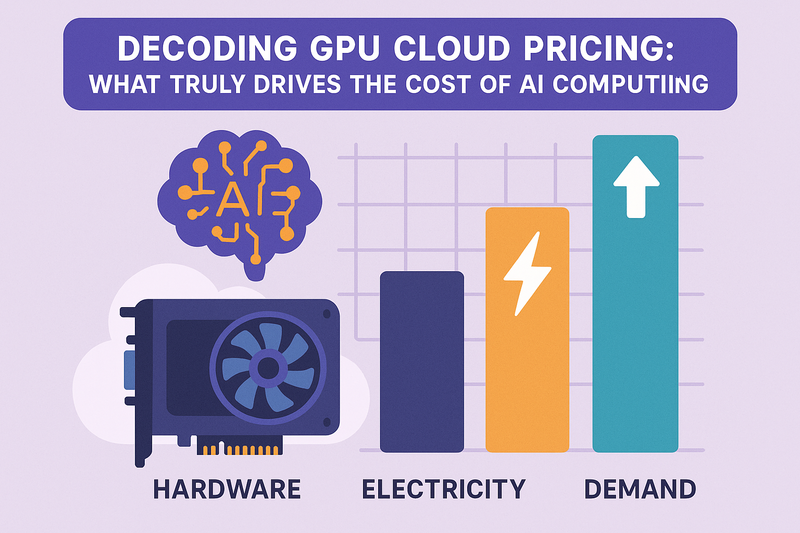The demand for accelerated computing has never been higher. From training massive language models to powering real-time recommendations and 3D rendering, enterprises increasingly rely on Graphics Processing Units (GPUs) in the cloud rather than maintaining costly on-premise infrastructure. However, one question persists across IT departments and financial offices alike—what determines GPU cloud pricing?
This blog breaks down the cost drivers, pricing models, and optimization strategies behind GPU cloud computing to help you make informed, cost-effective decisions.
Understanding the Basics of GPU Cloud Computing
Before analyzing pricing, it’s important to understand what GPU cloud computing entails. A GPU Cloud provides remote access to powerful GPU resources hosted in data centers. These virtualized GPUs handle massively parallel workloads that traditional CPUs cannot manage efficiently—especially tasks like deep learning model training, computer vision, and high-fidelity rendering.
Cloud-based GPUs deliver flexibility and scalability. You can run complex computations without owning expensive hardware, scale resources up or down on demand, and only pay for what you use—making them ideal for workloads that are resource-intensive but non-continuous.
Key Factors That Influence GPU Cloud Pricing
GPU cloud pricing varies significantly across providers, regions, and configurations. Here are the main factors that shape the overall cost:
1. GPU Type and Performance Level
The single largest influence on cost is the class of GPU used. High-end compute accelerators like NVIDIA A100 or H100 offer superior tensor performance, larger memory, and faster throughput for deep learning and HPC workloads. Naturally, their hourly pricing is much higher compared to mid-range GPUs such as the T4 or L4, which are optimized for lighter inference or visualization tasks.
2. Instance Configuration
Pricing also depends on how GPU instances are configured—whether single GPU, multi-GPU, or hybrid setups (CPU + GPU). Instances with multiple GPUs or additional CPU and memory capacity incur higher costs, while shared GPU instances may be offered at a lower rate for lighter tasks.
3. On-Demand vs. Reserved Usage
Most clouds offer multiple billing models.
On-demand pricing gives maximum flexibility but comes at a premium rate.
Reserved instances or long-term commitments lower hourly costs but require advance capacity planning.
Spot instances provide access to idle capacity at discounted rates but can be interrupted anytime, making them suitable for fault-tolerant workloads like parallel model training.
4. Data Center Region
GPU cloud pricing also depends heavily on regional infrastructure costs. Regions with higher energy costs, lower data center density, or regulatory requirements often have more expensive compute rates than zones with abundant green energy or optimized cooling infrastructures.
5. Data Transfer and Storage
The GPU isn’t the only cost driver. Cloud users often overlook data ingress, egress, and storage expenses. Large-scale AI projects generate terabytes of data, and moving or storing those datasets across regions and instances adds up significantly, especially if multiple transfers occur during model training or inference runs.
6. Software Stack and Licensing
GPU cloud services often include costs tied to specialized frameworks and software optimizations. For instance, machine learning frameworks like TensorFlow or PyTorch, along with proprietary inference runtimes and prebuilt libraries, can add hidden value—and sometimes extra licensing fees—to the overall pricing structure.
Common Pricing Models in GPU Clouds
The diversity in GPU cloud offerings means there isn’t a single universal pricing model. However, they can be grouped into a few standard structures:
Per-hour billing: The most common, ideal for short experiments or variable workloads.
Pay-per-second (usage-based): Fine-grained and cost-effective for quick tests or executions.
Preemptible/spot instances: Temporary resources offered at a fraction of on-demand rates.
Subscription or reserved plans: Fixed pricing for long-term use, ensuring predictable monthly or annual costs.
These models allow users to match the billing method with their workload’s predictability and tolerance for interruptions.
Why GPU Pricing Differs So Much Between Clouds
One might wonder: why can the same GPU cost vastly different amounts across cloud providers? The answer lies in total cost of ownership, economies of scale, and infrastructure maturity.
Some providers operate Tier IV data centers with enhanced redundancy, green cooling systems, and ultra-low-latency networks—contributing to slightly higher upfront pricing but improved performance consistency.
Others base pricing on optimized utilization of spare capacity, offering cheaper but less predictable throughput.
Additionally, bandwidth performance, storage type (NVMe vs. SSD), and AI workload support (FP32 vs. FP8 precision) influence GPU pricing beyond the raw hardware specs. These differences can be significant depending on whether the workload involves training, inference, visualization, or rendering.
How to Optimize GPU Cloud Spend
To manage GPU cloud costs without compromising on performance, consider these strategies:
Right-size GPU types: Match GPU specs with workload requirements. High-end GPUs are overkill for lightweight inference tasks.
Use mixed compute plans: Combine CPU and GPU instances to handle preprocessing and training separately for efficiency.
Leverage reserved and spot combinations: Reserve core capacity for predictable workloads and use spot instances for experimental or parallel tasks.
Monitor utilization metrics: Regularly check runtime metrics and shut down idle GPU instances.
Automate scaling: Dynamic orchestration tools can automatically spin up or down GPU resources, ensuring you pay only for live workloads.
Strategic planning and continuous monitoring can reduce cloud GPU bills by over 30–50% in many enterprise deployments.
Future of GPU Cloud Pricing
As AI models grow more sophisticated, GPU pricing structures are evolving. Some providers now offer fractional GPU usage—allowing users to rent part of a GPU rather than an entire one. Others are experimenting with time-sliced GPU scheduling, serverless GPU inference, and AI workload-based billing, where cost aligns directly with model training time or inference volume rather than raw instance hours.
Additionally, GPU cloud markets are trending toward transparent, modular pricing, helping businesses forecast budgets more accurately as they scale AI adoption.
Conclusion
GPU cloud pricing isn’t just about renting hardware—it’s about balancing performance, flexibility, and long-term scalability costs. Understanding the interplay between GPUtype, usage model, region, and workload requirements can significantly improve your return on investment in AI computing.
In an era where every millisecond of GPU time translates into innovation speed, the real advantage lies not in the cheapest instance—but in the smartest pricing strategy.




Top comments (1)
The Tropical Smoothie Menu offers a refreshing mix of smoothies, wraps, and bowls made with fresh, healthy ingredients. Each item is crafted to delight your taste buds and energize your day. Check out this healthy drink options to find flavors that perfectly suit your mood and lifestyle.